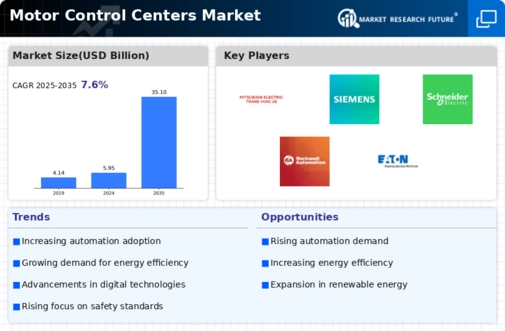-
Executive Summary
-
Research Methodology
-
Scope of the Study
- Definition
- Research Objective
- Assumptions
- Limitations
-
Research Process
- Primary Research
- Secondary Research
-
Market size Estimation
-
Forecast Model
-
Market Dynamics
-
Market Drivers
-
Market Inhibitors
-
Supply/Value Chain Analysis
-
Porter’s Five Forces Analysis
-
Global Motor Control Centers Market, By Type
-
Introduction
-
Conventional Motor Control Centers
-
Intelligent Motor Control Centers
-
Global Motor Control Centers Market, By Voltage
-
Introduction
-
Low voltage
-
Medium voltage
-
Global Motor Control Centers Market, By Component
-
Introduction
-
Busbars
-
Circuit Breakers & Fuses
-
Overload Relays
-
Variable Speed Drives
-
Soft Starters
-
Others
-
Global Motor Control Centers Market, By End User
-
Introduction
-
Utilities
-
Industrial
-
Commercial
-
Regional Market Analysis
-
Introduction
-
North America
- U.S.
- Canada
-
Europe
- U.K
- France
- Germany
- Spain
- Rest of Europe
-
Asia-Pacific
- China
- Japan
- India
- Rest of Asia-Pacific
-
Rest of the World
-
Competitive Analysis
-
Introduction
-
Competitive Scenario
- Market Share Analysis
- Market Development Analysis
- COMPONENT/Service Benchmarking
-
General Electric (U.S.)
- Overview
- Motor Control Centers Type/Service Offering
- Strategy
-
Siemens AG (Germany)
- Overview
- Motor Control Centers Type/Service Offering
- Strategy
-
ABB, Ltd. (Switzerland)
- Overview
- Motor Control Centers Type/Service Offering
- Strategy
-
Schneider Electric SE (France)
- Overview
- Motor Control Centers Type/Service Offering
- Strategy
-
Rockwell Automation (U.S.)
- Overview
- Motor Control Centers Type/Service Offering
- Strategy
-
Mitsubishi Electric Corporation (Japan)
- Overview
- Motor Control Centers Type/Service Offering
- Strategy
-
Hyosung Corporation (South Korea)
- Overview
- Motor Control Centers Type/Service Offering
- Strategy
-
Larsen & Toubro Limited (India)
- Overview
- Motor Control Centers Type/Service Offering
- Strategy
-
Technical Control Systems Ltd. (U.K)
- Overview
- Motor Control Centers Type/Service Offering
- Strategy
-
WEG S.A. (Brazil).
- Overview
- Motor Control Centers Type/Service Offering
- Strategy
-
LIST OF TABLES
-
GLOBAL MOTOR CONTROL CENTERS MARKET, BY TYPE
-
GLOBAL MOTOR CONTROL CENTERS MARKET, BY VOLTAGE
-
GLOBAL MOTOR CONTROL CENTERS MARKET, BY COMPONENT
-
GLOBAL MOTOR CONTROL CENTERS MARKET, BY END USER
-
GLOBAL MOTOR CONTROL CENTERS MARKET, BY REGIONS
-
NORTH AMERICA MOTOR CONTROL CENTERS MARKET, BY TYPE
-
NORTH AMERICA MOTOR CONTROL CENTERS MARKET, BY VOLTAGE
-
NORTH AMERICA MOTOR CONTROL CENTERS MARKET, BY COMPONENT
-
NORTH AMERICA MOTOR CONTROL CENTERS MARKET, BY END USER
-
U.S. MOTOR CONTROL CENTERS MARKET, BY TYPE
-
U.S. MOTOR CONTROL CENTERS MARKET, BY VOLTAGE
-
U.S. MOTOR CONTROL CENTERS MARKET, BY COMPONENT
-
U.S. MOTOR CONTROL CENTERS MARKET, BY END USER
-
CANADA MOTOR CONTROL CENTERS MARKET, BY TYPE
-
CANADA MOTOR CONTROL CENTERS MARKET, BY VOLTAGE
-
CANADA MOTOR CONTROL CENTERS MARKET, BY COMPONENT
-
CANADA MOTOR CONTROL CENTERS MARKET, BY END USER
-
EUROPE ENGINEERING PLASTICMARKET, BY TYPE
-
EUROPE MOTOR CONTROL CENTERS MARKET, BY VOLTAGE
-
EUROPE MOTOR CONTROL CENTERS MARKET, BY COMPONENT
-
EUROPE MOTOR CONTROL CENTERS MARKET, BY END USER
-
GERMANY MOTOR CONTROL CENTERS MARKET, BY TYPE
-
GERMANY MOTOR CONTROL CENTERS MARKET, BY VOLTAGE
-
GERMANY MOTOR CONTROL CENTERS MARKET, BY COMPONENT
-
GERMANY MOTOR CONTROL CENTERS MARKET, BY END USER
-
FRANCE MOTOR CONTROL CENTERS MARKET, BY TYPE
-
FRANCE MOTOR CONTROL CENTERS MARKET, BY VOLTAGE
-
FRANCE MOTOR CONTROL CENTERS MARKET, BY COMPONENT
-
FRANCE MOTOR CONTROL CENTERS MARKET, BY END USER
-
U.K. MOTOR CONTROL CENTERS MARKET, BY TYPE
-
U.K. MOTOR CONTROL CENTERS MARKET, BY VOLTAGE
-
U.K. MOTOR CONTROL CENTERS MARKET, BY COMPONENT
-
U.K. MOTOR CONTROL CENTERS MARKET, BY END USER
-
REST OF EUROPE MOTOR CONTROL CENTERS MARKET, BY TYPE
-
REST OF EUROPE MOTOR CONTROL CENTERS MARKET, BY VOLTAGE
-
REST OF EUROPE MOTOR CONTROL CENTERS MARKET, BY COMPONENT
-
REST OF EUROPE MOTOR CONTROL CENTERS MARKET, BY END USER
-
ASIA-PACIFIC MOTOR CONTROL CENTERS MARKET, BY TYPE
-
ASIA-PACIFIC MOTOR CONTROL CENTERS MARKET, BY VOLTAGE
-
ASIA-PACIFIC MOTOR CONTROL CENTERS MARKET, BY COMPONENT
-
ASIA-PACIFIC MOTOR CONTROL CENTERS MARKET, BY END USER
-
REST OF WORLD MOTOR CONTROL CENTERS MARKET, BY TYPE
-
REST OF WORLD MOTOR CONTROL CENTERS MARKET, BY VOLTAGE
-
REST OF WORLD MOTOR CONTROL CENTERS MARKET, BY COMPONENT
-
REST OF WORLD MOTOR CONTROL CENTERS MARKET, BY END USER
-
LIST OF FIGURES
-
RESEARCH APPLICATION
-
GLOBAL MOTOR CONTROL CENTERS MARKET: BY TYPE (%)
-
GLOBAL MOTOR CONTROL CENTERS MARKET: BY VOLTAGE (%)
-
GLOBAL MOTOR CONTROL CENTERS MARKET: BY COMPONENT (%)
-
GLOBAL MOTOR CONTROL CENTERS MARKET: BY END USER (%)
-
GLOBAL MOTOR CONTROL CENTERS MARKET: BY REGION
-
NORTH AMERICA MOTOR CONTROL CENTERS MARKET, BY TYPE (%)
-
NORTH AMERICA MOTOR CONTROL CENTERS MARKET, BY VOLTAGE (%)
-
NORTH AMERICA MOTOR CONTROL CENTERS MARKET, BY COMPONENT (%)
-
NORTH AMERICA MOTOR CONTROL CENTERS MARKET, BY END USER (%)
-
NORTH AMERICA MOTOR CONTROL CENTERS MARKET, BY COUNTRIES (%)
-
EUROPE MOTOR CONTROL CENTERS MARKET, BY TYPE (%)
-
EUROPE MOTOR CONTROL CENTERS MARKET, BY VOLTAGE (%)
-
EUROPE MOTOR CONTROL CENTERS MARKET, BY COMPONENT (%)
-
EUROPE MOTOR CONTROL CENTERS MARKET, BY END USER (%)
-
EUROPE MOTOR CONTROL CENTERS MARKET, BY COUNTRIES (%)
-
ASIA-PACIFIC MOTOR CONTROL CENTERS MARKET, BY TYPE (%)
-
ASIA-PACIFIC MOTOR CONTROL CENTERS MARKET, BY VOLTAGE (%)
-
ASIA-PACIFIC MOTOR CONTROL CENTERS MARKET, BY COMPONENT (%)
-
ASIA-PACIFIC MOTOR CONTROL CENTERS MARKET, BY END USER (%)
-
ASIA-PACIFIC MOTOR CONTROL CENTERS MARKET, BY COUNTRIES (%)
-
ROW MOTOR CONTROL CENTERS MARKET, BY TYPE (%)
-
ROW MOTOR CONTROL CENTERS MARKET, BY VOLTAGE (%)
-
ROW MOTOR CONTROL CENTERS MARKET, BY COMPONENT (%)
-
ROW MOTOR CONTROL CENTERS MARKET, BY END USER (%)
-
ROW MOTOR CONTROL CENTERS MARKET, BY COUNTRIES (%)








Leave a Comment